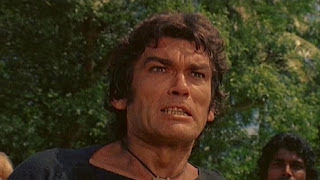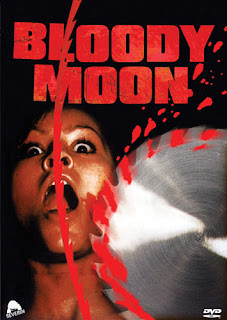Warning: This review contains scenes of nudity and bloody violence
AKA: Mangaiti Vivi!
Dir: Umberto Lenzi
Starring: Robert Kerman, Janet Agren, Ivan Rassimov, Paola Senatore, Me Me Lai, Mel Ferrer.
 In New York City, several murders are committed using darts
laced with deadly cobra venom. The murderer is hit by a truck and police are unable
to find any clues to his identity. They do, however, find some film footage
with the name of Diana Morris (Senatore) engraved on it. The cops call in
Diana’s sister, Sheila (Agren), who explains that she hasn’t heard from her
sister in weeks. The footage shows Diana in the jungle taking part in some sort
of strange ritual. Professor Carter (Ferrer) informs Sheila that what she saw
in the footage was a ‘purification ritual’ performed by a cult in New Guinea. Determined to find her sister and bring her
home, Sheila sets off for New Guinea where she tracks down Mark Butler (Kerman)
to help her. Mark is reluctant at first, but is soon persuaded by Sheila’s
offer of $80,000. After days searching the jungle Mark and Sheila are taken in
by the cult who are led by the messiah-like figure of Jonas (Rassimov). Jonas
conducts his followers to perform strange rituals and obey his rules. Those who
disobey his command are banished from the sect and left to wander in the jungle
where a vicious cannibal tribe lurks. When Mark and Sheila catch up with Diana
it’s revealed that Jonas maintains his followers’ obedience by forcing them to
drink brainwashing liquids. The three of them, along with a native, escape the
camp only to run into the cannibals on their way and when Jonas realises that
his perfect colony might be under threat, he asks that his followers perform
one final sacrifice.
In New York City, several murders are committed using darts
laced with deadly cobra venom. The murderer is hit by a truck and police are unable
to find any clues to his identity. They do, however, find some film footage
with the name of Diana Morris (Senatore) engraved on it. The cops call in
Diana’s sister, Sheila (Agren), who explains that she hasn’t heard from her
sister in weeks. The footage shows Diana in the jungle taking part in some sort
of strange ritual. Professor Carter (Ferrer) informs Sheila that what she saw
in the footage was a ‘purification ritual’ performed by a cult in New Guinea. Determined to find her sister and bring her
home, Sheila sets off for New Guinea where she tracks down Mark Butler (Kerman)
to help her. Mark is reluctant at first, but is soon persuaded by Sheila’s
offer of $80,000. After days searching the jungle Mark and Sheila are taken in
by the cult who are led by the messiah-like figure of Jonas (Rassimov). Jonas
conducts his followers to perform strange rituals and obey his rules. Those who
disobey his command are banished from the sect and left to wander in the jungle
where a vicious cannibal tribe lurks. When Mark and Sheila catch up with Diana
it’s revealed that Jonas maintains his followers’ obedience by forcing them to
drink brainwashing liquids. The three of them, along with a native, escape the
camp only to run into the cannibals on their way and when Jonas realises that
his perfect colony might be under threat, he asks that his followers perform
one final sacrifice. Despite its glaring cover art and scenes of tribesmen feasting on human flesh, Eaten Alive doesn’t quite feel like a full blown cannibal movie. Indeed the cannibals are on the fringes of things for most of the movie and don’t really make their presence known until the final quarter of an hour. This is more of a jungle adventure movie and a parable about religious cults that just happens to feature some cannibals. Although it’s an enjoyable enough watch it’s also handicapped by some familiar scenes that have been borrowed from other films and that controversial and unnecessary hallmark of the genre: animal cruelty.
 Eaten Alive! Sees
Umberto Lenzi return to the jungle and it acts as a slight precursor to Cannibal Ferox, which was made a year
later. However, the two films are very different. Ferox is the perfect movie for those looking for some serious
gut-munching mayhem. Eaten Alive!,
while it has its moments, is not a quintessential cannibal movie. Its main
story is inspired by religious cults and particularly by the famous People’s
Temple cult. The character of Jonas is meant to represent that cult’s notorious
leader Jim Jones and the film resembles several elements of the famous Jonestown
incident: the jungle location, the rule that members are forbidden to leave,
the mass suicide. Like the Jonestown residents, Jonas’ cult members are forced
to drink liquids laced with poison. However, unlike Jones, Jonas does not
participate in the suicide – we’re left unaware of his fate, though. Thanks to the emergence of Scientology into
the mainstream via the patronage of several high-profile celebrities, Jim Jones
and the People’s Temple are often forgotten about now when we think of
religious sects. But it was a huge story in the late ‘70s and when Eaten Alive! was released in 1980 its
allusion to the incident would’ve been instantly recognisable by most
audiences. The film may also have taken inspiration from Apocalypse Now, which
was released the previous year.
Eaten Alive! Sees
Umberto Lenzi return to the jungle and it acts as a slight precursor to Cannibal Ferox, which was made a year
later. However, the two films are very different. Ferox is the perfect movie for those looking for some serious
gut-munching mayhem. Eaten Alive!,
while it has its moments, is not a quintessential cannibal movie. Its main
story is inspired by religious cults and particularly by the famous People’s
Temple cult. The character of Jonas is meant to represent that cult’s notorious
leader Jim Jones and the film resembles several elements of the famous Jonestown
incident: the jungle location, the rule that members are forbidden to leave,
the mass suicide. Like the Jonestown residents, Jonas’ cult members are forced
to drink liquids laced with poison. However, unlike Jones, Jonas does not
participate in the suicide – we’re left unaware of his fate, though. Thanks to the emergence of Scientology into
the mainstream via the patronage of several high-profile celebrities, Jim Jones
and the People’s Temple are often forgotten about now when we think of
religious sects. But it was a huge story in the late ‘70s and when Eaten Alive! was released in 1980 its
allusion to the incident would’ve been instantly recognisable by most
audiences. The film may also have taken inspiration from Apocalypse Now, which
was released the previous year.
Much like many other films in the cannibal sub-genre such as
Lenzi’s own Man from Deep River and Cannibal Ferox; as well Ruggero
Deodato’s Cannibal Holocaust and
Sergio Martino’s Mountain of theCannibal God, Eaten Alive! feels
the need to employ real scenes of animal cruelty and slaughter as shock value.
This practice has understandably been condemned numerous times by critics of
these films and I don’t want to touch on this subject too much here. I will say that I do not condone the
needless killing of animals for entertainment and thankfully such practices do
not exist in movies today.
 |
| You like rock [music]? No, I like whiskey |
 Some familiar faces show up in Eaten Alive! Robert Kerman puts in another good performance in the
lead role of Mark Butler. Unlike the more restrained role of Professor Harold
Monroe in Cannibal Holocaust, Kerman
looks to be having fun as the macho adventurer Mark. As well as Deodato’s
classic, Kerman would also show up in a minor role in Lenzi’s Cannibal Ferox.
Some familiar faces show up in Eaten Alive! Robert Kerman puts in another good performance in the
lead role of Mark Butler. Unlike the more restrained role of Professor Harold
Monroe in Cannibal Holocaust, Kerman
looks to be having fun as the macho adventurer Mark. As well as Deodato’s
classic, Kerman would also show up in a minor role in Lenzi’s Cannibal Ferox. Swedish actor Janet Agren is also decent here as Sheila. She plays a type of southern belle in Eaten Alive and is quite a resourceful woman who can hold her own up against the brash Butler. Her quest to save her sister is noble but she’s terrified of the cannibals and, at one point, begs Mark to kill her before the natives do. A former model, Agren also features in Lucio Fulci’s City of the Living Dead and alongside Arnold Schwarzenegger in Red Sonja.
Ivan Rassimov is particularly menacing as Jonas. He is also
a veteran of the cannibal movie, having starred in both Man from Deep River and Last
Cannibal World. As is Me Me Lai, who has a minor role as a native woman who
helps Mark, Sheila and Diana escape from the camp. Finally the very beautiful
Paola Senatore will be familiar to fans of Joe D’Amato’s Nunsploitation film Images in a Convent.
 |
| "Their idea of lunch is fresh, hot entrails soaked in blood" - Jonas |

.jpg)




























